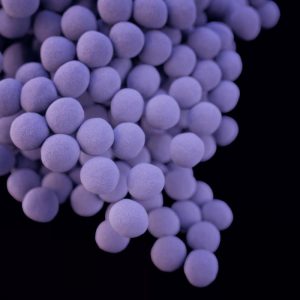Menzies School of Health Research (Menzies) scientists have uncovered two new species of staphylococcus.

Image/CDC
One of the two has been officially registered as Staphylococcus argenteus, or more commonly Silver Staph. Menzies School of Health Research (Menzies) senior research fellow Associate Professor Steven Tong says both species; S. argenteus and S. schweitzeri may not be distinguished in the laboratory from golden staph (Staphyococcus aureus) using standard laboratory techniques.
S. aureus causes a heavy burden of disease across the world, especially in the NT where it is the most commonly isolated bacteria in the Royal Darwin Hospital.
“The discovery is important because it deepens our understanding of the whole group of Staphylococci which are a major cause of human disease,” A/Prof Tong said. The research group has spent the past 10 years looking into the genetic sequences of golden staph recovered from NT communities. Some strains looked different with regards to their DNA sequence, leading to further investigations.
“We came across some unusual results while investigating the genetic sequences of golden staph from the NT and across the world. During this process we noticed some strains isolated from monkeys in Africa also looked unusual so we decided to combine efforts with collaborators in Munich, Germany who had collected these monkey strains. Further investigations showed us we were dealing with three entirely separate species. These weren’t just different makes of cars, but different types of vehicles,” A/Prof Tong said.
Menzies have been using the latest DNA sequencing technology in collaboration with the Wellcome Trust Sanger Institute in Cambridge, UK to definitively show that there is sufficient genetic distance between S. argenteus, S. schweitzeri and S. aureus for them to be formally recognized as different species.
“While initially concerning more recent studies have shown that silver staph causes less severe disease. However, the silver staph has demonstrated an ability to become resistant to penicillin like antibiotics just like golden staph which has become methicillin-resistant Staphylococcus aureus (MRSA). In fact, these different species can swap genes with each other – a bit like bacteria having sex.” Menzies director, Professor Alan Cass said the study highlighted the world-class quality of research being undertaken by Menzies and its key partners.
“This is a perfect example of how Menzies researchers are working collaboratively on discovery research that has the potential to greatly improve the health of Indigenous Australians and millions of others around the world.” When asked why the discovery is important A/Prof Tong explains, “researchers and doctors all over the world are now able to look more specifically at the kinds of disease that these new species cause. It is likely that infections due to the different species can be treated differently.
Additionally, the scientific community can now look at what sets S. aureus apart from the other two species and understand why it is better able to cause disease”.


One thought on “‘Silver Staph’, Staphylococcus argenteus discovered by Australian researchers”